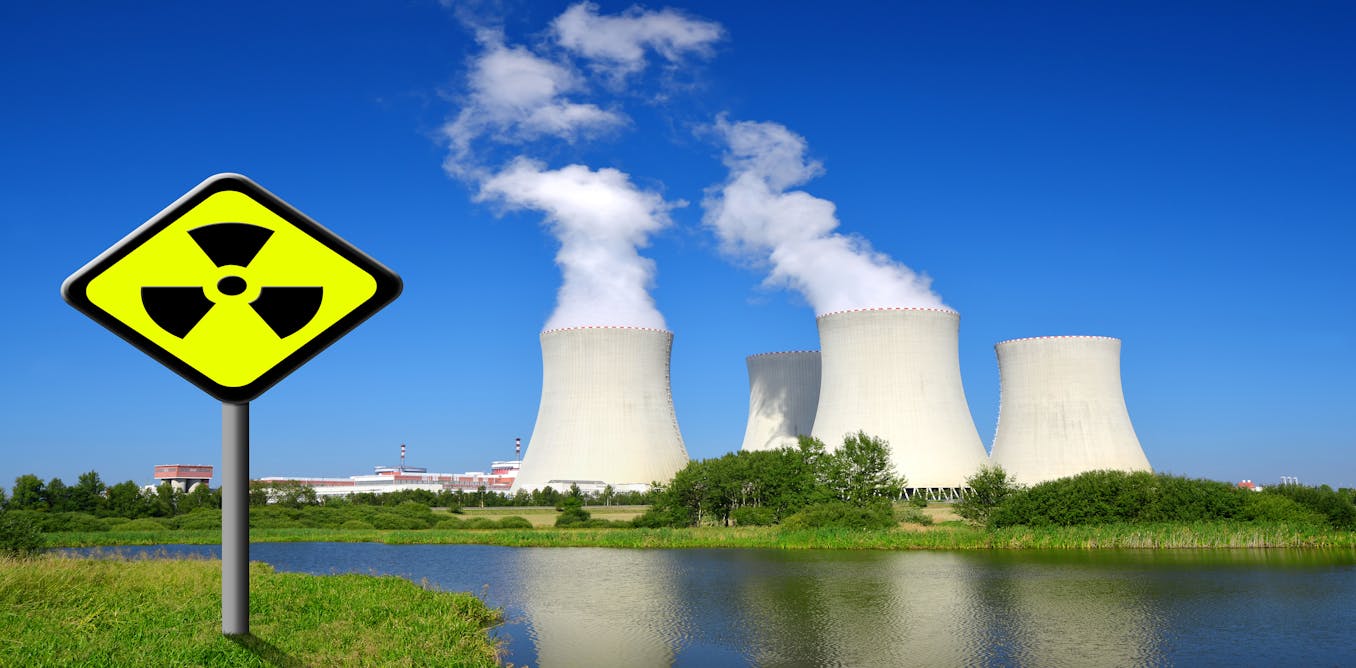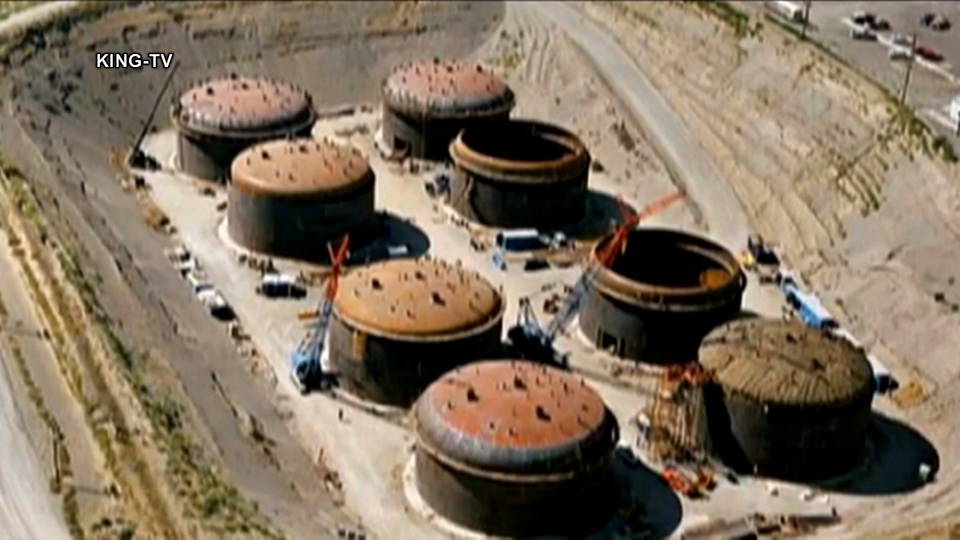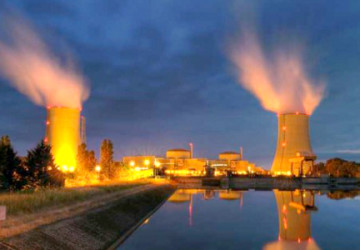
Nuclear Reactors Are Military and Terrorist Targets
Gar Smith / Environmentalists Against War (Excerpted from the award-winning book, Nuclear Roulette, Chelsea Green 2012)
Nuclear terrorism is still often treated as science fiction — I wish it were. — Former UN General Secretary Kofi Annan
For more than half a century, civilian nuclear reactors have posed a clear and present danger to national security. The government has been largely silent on the danger and the public has been unaware of the peril. But on June 7, 1981, an Israeli jet raid on the French-built Osirak nuclear reactor situated on the outskirts of Baghdad blew the lid off Pandora’s box. The secret was out: “peaceful, civilian nuclear reactors” are strategic targets.
This last dirty secret of the Atomic Age, once it is understood, places the promoters of nuclear power in an ironic no-win position. Their dilemma is simply this: nuclear weapons and nuclear reactors cannot coexist.
The danger was spelled out in a Current Affairs Bulletin article in 1982. In the event of a major war, author Brian Martin wrote: “It is possible that nuclear power reactors would be nuclear targets, because of their high economic value, because of their capability of producing plutonium for making nuclear weapons, or because of the devastating radioactivity that would be spread about…. The main concentrations of large nuclear reactors are found in the United States, Europe, the Soviet Union, and Japan, that is, those areas most likely to be involved in nuclear war.”
As Bennett Ramberg, a former research associate with the Center for International and Strategic Affairs at the University of California at Los Angeles, noted shortly after the Israeli attack: “Reactors are seductive targets. They represent one of the greatest concentrations of capital investment a nation is likely to possess.”
In addition to the 1981 attack, Israel destroyed a suspected nuclear site in Syria in 2008 and has threatened to bomb nuclear research facilities in Iran. The United States has also threatened to bomb Iranian nuclear sites.
In the 1960s and early 1970s, reactors were not thought to be attractive military targets, since they were small (1,000 MW and less) and missiles were only accurate to within a half-mile of a distant target. But as Oak Ridge National Laboratory researchers Conrad and Rowena Chester correctly predicted in 1976, “From the 1980s through the end of the century, the situation will be quite different.”
In 2014, 108 million people in the United States — nearly a third of the population — were living within 50 miles of a nuclear plant. In 2020, more than three million Americans lived within 10 miles of an operating nuclear plant.

A Nuclear Blind Spot
A disturbing conspiracy of silence seems to surround any recognition of this pervasive danger. The Atomic Energy Commission’s 1962 study on The Effects of Nuclear Weapons contains the first reference to the effect of atomic war on electric power generation. While admitting that Hiroshima’s electrical system had “suffered severely” from the atomic blast, the study concluded with the reassurance that “although the pole lines would have required some rebuilding, the general damage was such that it could have been repaired within a day or so with materials normally carried in stock by utility companies.”
In 1962, of course, nuclear power stations had not yet become a part of the American landscape. Yet when the Department of Energy issued an updated version of The Effects of Nuclear Weapons in 1977, the chapter on nuclear threats to the American power system was reprinted without any mention of the nation’s 75 operating atomic reactors.
In 1975, Secretary of Defense James Schlesinger unveiled a new nuclear strategy of “flexible response” (a more limited alternative to all-out “Mutually Assured Destruction”) and the National Academy of Sciences issued a report that, for the first time, acknowledged that civilian reactors “may pose special problems” in a nuclear war. But the report failed to address these problems.
In 1979, the Congressional Office of Technology Assessment (OTA) published a major study on the impacts of nuclear conflict, which warned that, in the event of an enemy missile attack, “the most vulnerable element of the US economy was judged to be the energy supply system.” Remarkably, America’s nuclear power facilities were not mentioned.
The OTA report equated the “energy supply system” with the nation’s 300 oil refineries. The OTA’s hypothetical attack scenario for Philadelphia targeted four conventional power plants — Delaware, Schuylkill, Southwark, and Richmond — but said nothing of the state’s nuclear plants at Shippingport, Three Mile Island, and Peach Bottom — the latter located only 70 miles west of Philadelphia.
The consistent omission of references to nuclear reactors in these assessments of the vulnerability of the United States to attack is exceedingly odd, given the strategic importance of the electric power grid. But the silence could have been intended to avoid drawing undue attention to the prime reason civilian reactors play a special role in the thinking of nuclear war-gaming strategists.
The conspiracy of silence is even more remarkable give that Sir Brian Flowers, a prominent British nuclear physicist, described the problem back in 1976. Flowers pointed out that if nuclear power plants had been built and deployed in Europe before World War II, large parts of Europe would be uninhabitable today because of conventional warfare and conventional sabotage directed against those nuclear plants.
In 2011, the international organization, Mayors for Peace, drew new attention to one of the chilling conclusions from Flowers’s 35-year-old report: “If your enemy has nuclear power plants then you don’t need nuclear weapons — you can achieve much the same effect by tripping up the power plants and making them melt down.” In most cases, this can be done just by disabling both on-site and off-site power, and then compromising the containment system for good measure. The spent fuel bay is an even easier target, and as a bonus, it contains even more radioactivity than is present in the reactor core.
What Happens If . . .
While billions of dollars have been spent to “harden” military bases against nuclear attack, large nuclear power complexes remain strategic sitting ducks. If a single one-megaton nuclear warhead can unleash the same amount of energy as the volcanic eruption that decapitated Mount St. Helens, what could happen if a nuclear missile were to land near the containment vessel of a nuclear reactor?
In the early 1980s, two Massachusetts Institute of Technology scientists, Kosta Tsipis and Steve Fetter, set out to investigate just such an eventuality, exploring what would happen if a single one-megaton weapon were exploded at a 1000 MW reactor. (To put this in perspective, the payload of a nuclear-armed Minuteman missile is approximately one megaton, equal to about 50 times the explosive power of the Hiroshima bomb). [NWR8]
“The lethal zone for the detonation of the weapons on the reactor would be more than 500 square miles, an area a third larger than the lethal zone created by the detonation of the weapons alone,” Tsipis and Fetter estimated. A fireball rising 12 miles into the sky would carve a crater 400 feet deep and spread a lethal blanket of molten rock and white ash over 4,500 square miles.
In addition to the millions who would die immediately, the reactor-bomb detonation would result in a 30 percent increase in delayed casualties, over what might be expected from detonation of the weapon alone. Anyone who could not relocate swiftly could be dead within two months.
While the area contaminated by the reactor-bomb combination would not be “significantly” larger, Tsipis and Fetter state, “the length of time a given area is made uninhabitable . . . [is] ten times larger in the case of the reactor-bomb combination.” This is because a bomb yields generally short-lived fallout, while blasting open a reactor core would scatter long-lived isotopes over the land.
The total loss would be “of the order of 4,000 square-mile-years; consequently it would result in vast capital losses that would dwarf losses from any other single natural disaster in the history of the modern world,” the MIT study concluded. Hundreds of square miles would remain “inaccessible for over a hundred years, creating a permanent monument to the event. It is doubtful that decontamination procedures could mitigate these losses, even if decontamination proved cost-effective.”
All this, remember, from one bomb hitting one reactor.
Tsipis and Fetter cautioned that these estimates rested on a “best case” assumption that “there will be no neutron activation or fission of reactor materials by the fast neutrons of the weapon.” If that were to happen, there might be a second explosion within the first explosion.
Tsipis and Fetter’s conclusion is one that has certainly not been lost on the Pentagon war gamers. Striking a reactor with a missile renders a “dirty explosion” even dirtier and, in so doing, it becomes an effective way to devastate large portions of an entire nation with minimal effort. If World War III were to break out, a missile attack on reactors in the Northern Hemisphere would envelop the entire United States in fallout and eradicate Western Europe. Only Russia — with fewer reactors and a greater landmass — would escape total obliteration.

A leaking nuclear waste storage site in Washington state.
Fortified Fallout
Tsipis and Fetter also looked at the probable results of a single nuclear weapon exploding over a single civilian nuclear waste storage site at West Valley, New York. At the time of their study, in the early 1980s, this site (located near Buffalo) included a single steel tank containing 600,000 gallons of high-level radioactive waste that had been generated by the defunct Nuclear Fuel Services reprocessing plant. (Compare that to the 37 million gallons of radioactive wastes stored in 49 leaking tanks at the DOE’s Savannah River Site, 60 miles upwind of Charleston, South Carolina.)
“If a one-megaton weapon exploded directly above these steel tanks,” Tsipis and Fetter warned, “their radioactive contents would rise with the fireball and join the weapons debris” to form the deadliest fallout imaginable. It would extinguish all life in an area the size of Utah (85,000 square miles). One year later, this no-man’s-land would still be the size of the state of Washington. After 10 years, the dead land would equal the acreage of West Virginia. After 100 years, a tract of land the size of Rhode Island would remain permanently poisoned with radioactivity.
All the legacy of a single one-megaton bomb.
Tsipis and Fetter concluded that it would be “unrealistic to expect that, in a nuclear exchange, only one or just a few ground bursts of nuclear weapons will occur.” More likely, the US continent would reel and buckle under “the near simultaneous detonation of hundreds and even thousands of megaton-sized nuclear warheads.”
Underground Zero?
In 1980, when vice president George H. W. Bush spoke of a “winnable” nuclear war with 20 million “acceptable” dead, his glib optimism was based on the narrow focus of war gamers who are not overly concerned about the loss of lives. As the Reagan-era wargamers understood it, the “game” would be won if they could assure the “survivability” of their nuclear response. But what about the “survivability” of nuclear reactors and the civilian populations?
As Thomas K. Jones, President Reagan’s Deputy Under Secretary of Defense for Strategic and Theater Nuclear Forces blithely observed: “Everybody’s going to make it if there are enough shovels to go around. Dig a hole, cover it with a couple of doors and then throw three feet of dirt on top.”
In the dawn of the Atomic Age (at least as early as 1958), there were plans to place reactors underground. As physicist Edward Teller (the “father of the atomic bomb”) was prone to remark, nuclear reactors are not foolproof. Given this reality, it was argued that “undergrounding” would provide the best protection against a catastrophic reactor mishap. Since undergrounding would also enhance the survival of nuclear complexes in the event of military or terrorist attack, why was it that all of America’s plants wound up being built on the surface?
An answer can be found in an obscure report in a 1974 issue of Nuclear Safety magazine. “Siting of nuclear plants underground has not proliferated for various reasons,” the author explained, including the lack of suitable sites, licensing uncertainties, and “apparent economic penalty.”
The report projected that the cost of excavating 770,000 cubic yards of earth to safely bury the Indian Point 3 reactor would have cost the private utility company owners an additional $21 million (nearly $111 million in 2020 dollars), adding 10 percent to the cost and 2.5 years of additional construction to the completion of the facility. The reason why reactors were placed in plain sight was simply because plant safety and national security were not deemed cost-effective for utility investors.

Indian Point Nuclear Plant: 38 miles from New York City.
What Are the Options?
MIT researchers Tsipis and Fetter called for a formal scientific investigation of the dangers disclosed in their report. They also challenged government leaders to begin an international public education campaign on the danger of nuclear weapons. While the dangers of a nuclear accident can be widespread and long-lasting (as were borne out by the events at Chernobyl and Fukushima), an explosion or meltdown at a nuclear reactor is nothing compared to the detonation of even the smallest tactical nuclear weapon. For these reasons, the MIT researchers charged, “the nuclear industry, the scientific authorities, and the government in this and other countries must be faulted for maintaining this state of public ignorance.”
Meanwhile, the potential for nuclear terrorism continues to grow. From a terrorist perspective, a nuclear power plant is a ready-made weapon, already positioned to do the most damage. Some 53,000 metric tons of highly radioactive spent fuel sit in storage pools upwind of major US cities, and 90 percent have no protection against a terrorist attack.
Blowing up a spent fuel storage site could unleash a devastating plume of fallout over civilian populations. Benjamin Sovacool, a public policy professor at the National University of Singapore, estimates that such an attack could kill 43,700 people instantly, cause 518,000 subsequent cancer deaths, and require around $2 trillion in decontamination and restoration costs.
These facts have not gone unnoticed; the mastermind of the 9/11 attacks reportedly claimed that Al Qaeda had planned to strike US reactor sites.
Although it has been little publicized, there have been a number of terrorist attacks directed at nuclear installations. In 2001, the energy information organization WISE-Paris, published a report documenting 13 such attacks between 1977-1999. One of the more remarkable assaults occurred in France on January 18, 1982, when a nighttime raid sent five RPG-7 rocket-propelled grenades streaking over the Rhone in the direction of the unfinished Superphénix breeder reactor. Two of the rockets struck the facility, causing minor damage. (The attack was initially blamed on the international terrorist known as “Carlos the Jackal” but, in a bizarre twist, Chaim Nissim — an elected Green Party member of the Swiss Parliament — ultimately claimed responsibility in 2003.)
Given this past history of attacks targeting nuclear facilities, America’s — and indeed the world’s — close links to the nuclear power industry need to be radically rethought. Each of the civilian reactors operating in the United States today constitutes a potential homegrown doomsday machine.
In an age of nuclear-armed ballistic weapons, each new reactor placed in operation becomes a new target — with a 40-to-1 payoff in death for any incoming missile that strikes it. (And it wouldn’t take a missile strike. A land-based terrorist attack could potentially disable a nuclear plant’s power systems, leading to a meltdown and/or spent fuel ignition.)
The conclusion is as inescapable as it is ironic: surface-based nuclear reactors are not consistent with national security. Not ours, not anyone’s. Nuclear reactors endanger national security.
It follows that any sincere proponent of military preparedness would have to press for the elimination of nuclear reactors as inexcusably tempting targets of opportunity. On the other hand, advocates of nuclear-generated electric power will be compelled to oppose the continued existence of nuclear weapons — one of the few forces capable of breaching the protective shield of an atomic reactor.
The nuclear fraternity can’t have it both ways. Atomic power? Atomic bombs? They are simply incompatible.
Sources
• Jim Riccio, “Nuclear Plants Are Vulnerable to Earthquakes, Hurricanes, and Attacks — Are You at Risk?” Greenpeace, August 26, 2011.
• Bill Dedman, “Who’s Afraid of Nuclear Power? Not the American People,” MSNBC, April 14, 2011.
• Gar Smith, “Nuclear Reactors and War: The Conspiracy that Puts Us All at Risk,” The Edge.org, August 15, 2002.
• Kosta Tsipis and Steve Fetter, “Catastrophic Radiation Releases.” MIT, April 1981.
• “Radioactive Tank Waste from the Production of Nuclear Weapons: Background and Issues for Congress,” Congressional Research Service, January 3, 2007.